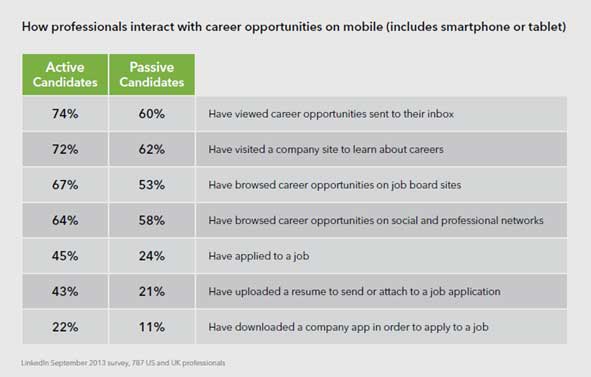According to a recent iMomentous report, 36 percent of Fortune 500 companies have a mobile career section on their site, but only 5 percent have actual “mobile apply” capabilities. How do your recruiting efforts stack up to these statistics? And – assuming your organization is not on the Fortune 500 list – how much effort should you put into mobile-friendly recruiting? You may find the answers surprising.
How important is it to have a mobile-friendly recruiting strategy? Indeed.com – now the Internet’s number one source of online job postings with 3 billion searches conducted each month, with offices in Austin, TX – traces one-third of its search traffic back to mobile devices.
LinkedIn.com has found that both active and passive job candidates are already searching your jobs via mobile, whether you’re ready for them or not. In a September 2013 survey, the social networking giant found these compelling statistics:

“This data proves that both active and passive candidates are using mobile devices to search for and discover jobs,” a LinkedIn representative explained to us. “Yet only 20 percent of recruiters felt their career sites were optimized for mobile. This is a big problem that will only worsen if employers don’t take mobile recruiting more seriously.”
Another study conducted by Simply Hired found that 84 percent of job seekers believe employers should have mobile-friendly sites and 85 percent said they would apply from a mobile device if the option was available. The study also shows that job seekers looking for jobs via mobile devices:
- Click on 60 percent more jobs.
- Spend 27 percent more time looking at jobs.
- Spend 25 percent more time in each session.
- Are 30 percent more likely to take a second look at the site within a week.
These compelling statistics are reasons to give your mobile job site some love. But where do you start?
“It’s important to accommodate job seekers in the areas where they’re looking. And, increasingly, candidates are looking for jobs on their mobile devices,” says Mark Turpin, CEO/co-founder, HT Staffing. “That doesn’t mean that you need to over-extend your resources to make mobile search a priority. However, your first step should be to make sure that what you do have available isn’t creating a stumbling block.”
Such stumbling blocks may include:
- Neglecting how your company website or careers page appears to mobile candidates. Consider a simple dynamic design that looks great and functions well on mobile and desktops/laptops. Whether you allow ‘mobile apply’ functionality or not, be sure your ‘apply’ directions are clear and easy to spot.
- Ignoring how important your organization’s social networking presence affects mobile recruiting. Social sites like Facebook, LinkedIn and Twitter are huge entry points for mobile job seekers, so make sure your social pages are professionally maintained. LinkedIn staff asked Phil Hendrickson, talent acquisition specialist at Starbucks, to offer advice to other recruiters in this area: “Consult with your web team to see what percentage of your careers site traffic comes from mobile,” said Henderickson. “This information can help you understand your mobile audience and make the appropriate business decisions.”
- Neglecting to hire traditional headhunters or staffing specialists in order to attract top-level recruits and passive candidates. Mobile search isn’t a catch-all for candidates; your staffing specialist can help you decide when other recruiting strategies are needed to produce the best results.
As you hit the mobile job search highway this year, let us know what you learn along the way. We’d love to know if your experience matches the research.
Image credit: rangizzz / 123RF Stock Photo



